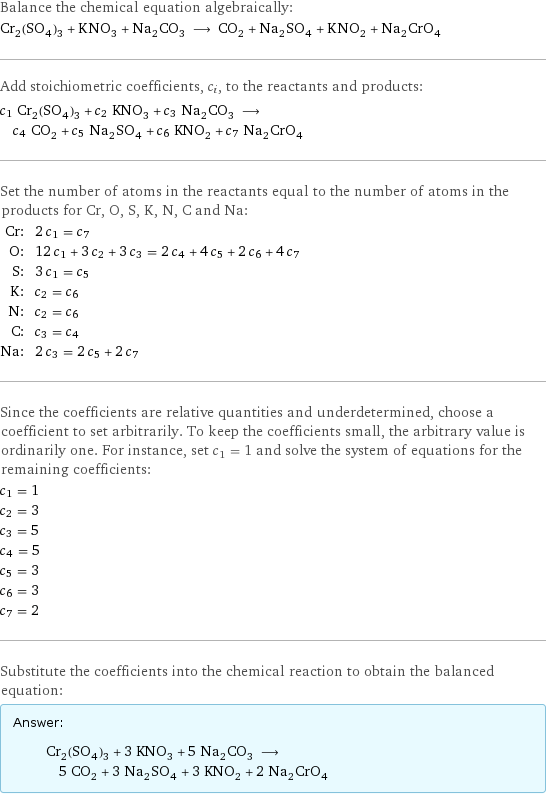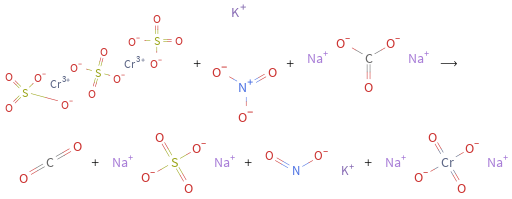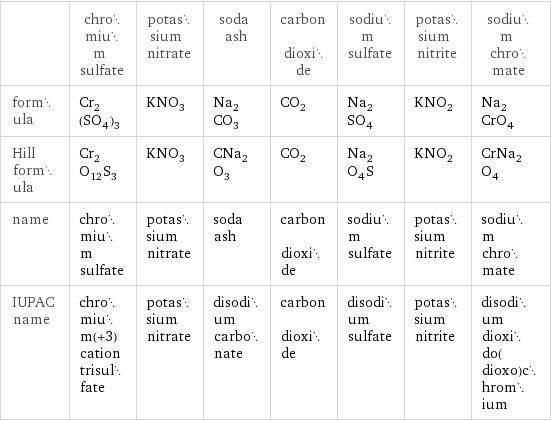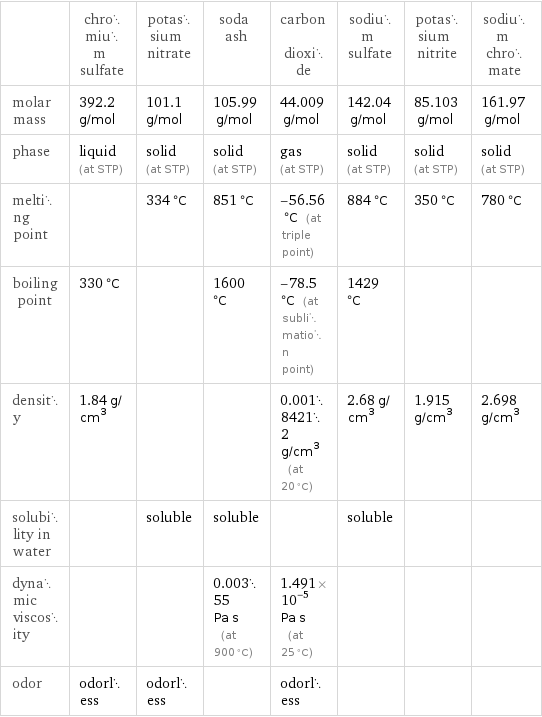Input interpretation

Cr_2(SO_4)_3 chromium sulfate + KNO_3 potassium nitrate + Na_2CO_3 soda ash ⟶ CO_2 carbon dioxide + Na_2SO_4 sodium sulfate + KNO_2 potassium nitrite + Na_2CrO_4 sodium chromate
Balanced equation

Balance the chemical equation algebraically: Cr_2(SO_4)_3 + KNO_3 + Na_2CO_3 ⟶ CO_2 + Na_2SO_4 + KNO_2 + Na_2CrO_4 Add stoichiometric coefficients, c_i, to the reactants and products: c_1 Cr_2(SO_4)_3 + c_2 KNO_3 + c_3 Na_2CO_3 ⟶ c_4 CO_2 + c_5 Na_2SO_4 + c_6 KNO_2 + c_7 Na_2CrO_4 Set the number of atoms in the reactants equal to the number of atoms in the products for Cr, O, S, K, N, C and Na: Cr: | 2 c_1 = c_7 O: | 12 c_1 + 3 c_2 + 3 c_3 = 2 c_4 + 4 c_5 + 2 c_6 + 4 c_7 S: | 3 c_1 = c_5 K: | c_2 = c_6 N: | c_2 = c_6 C: | c_3 = c_4 Na: | 2 c_3 = 2 c_5 + 2 c_7 Since the coefficients are relative quantities and underdetermined, choose a coefficient to set arbitrarily. To keep the coefficients small, the arbitrary value is ordinarily one. For instance, set c_1 = 1 and solve the system of equations for the remaining coefficients: c_1 = 1 c_2 = 3 c_3 = 5 c_4 = 5 c_5 = 3 c_6 = 3 c_7 = 2 Substitute the coefficients into the chemical reaction to obtain the balanced equation: Answer: | | Cr_2(SO_4)_3 + 3 KNO_3 + 5 Na_2CO_3 ⟶ 5 CO_2 + 3 Na_2SO_4 + 3 KNO_2 + 2 Na_2CrO_4
Structures

+ + ⟶ + + +
Names

chromium sulfate + potassium nitrate + soda ash ⟶ carbon dioxide + sodium sulfate + potassium nitrite + sodium chromate
Equilibrium constant
![Construct the equilibrium constant, K, expression for: Cr_2(SO_4)_3 + KNO_3 + Na_2CO_3 ⟶ CO_2 + Na_2SO_4 + KNO_2 + Na_2CrO_4 Plan: • Balance the chemical equation. • Determine the stoichiometric numbers. • Assemble the activity expression for each chemical species. • Use the activity expressions to build the equilibrium constant expression. Write the balanced chemical equation: Cr_2(SO_4)_3 + 3 KNO_3 + 5 Na_2CO_3 ⟶ 5 CO_2 + 3 Na_2SO_4 + 3 KNO_2 + 2 Na_2CrO_4 Assign stoichiometric numbers, ν_i, using the stoichiometric coefficients, c_i, from the balanced chemical equation in the following manner: ν_i = -c_i for reactants and ν_i = c_i for products: chemical species | c_i | ν_i Cr_2(SO_4)_3 | 1 | -1 KNO_3 | 3 | -3 Na_2CO_3 | 5 | -5 CO_2 | 5 | 5 Na_2SO_4 | 3 | 3 KNO_2 | 3 | 3 Na_2CrO_4 | 2 | 2 Assemble the activity expressions accounting for the state of matter and ν_i: chemical species | c_i | ν_i | activity expression Cr_2(SO_4)_3 | 1 | -1 | ([Cr2(SO4)3])^(-1) KNO_3 | 3 | -3 | ([KNO3])^(-3) Na_2CO_3 | 5 | -5 | ([Na2CO3])^(-5) CO_2 | 5 | 5 | ([CO2])^5 Na_2SO_4 | 3 | 3 | ([Na2SO4])^3 KNO_2 | 3 | 3 | ([KNO2])^3 Na_2CrO_4 | 2 | 2 | ([Na2CrO4])^2 The equilibrium constant symbol in the concentration basis is: K_c Mulitply the activity expressions to arrive at the K_c expression: Answer: | | K_c = ([Cr2(SO4)3])^(-1) ([KNO3])^(-3) ([Na2CO3])^(-5) ([CO2])^5 ([Na2SO4])^3 ([KNO2])^3 ([Na2CrO4])^2 = (([CO2])^5 ([Na2SO4])^3 ([KNO2])^3 ([Na2CrO4])^2)/([Cr2(SO4)3] ([KNO3])^3 ([Na2CO3])^5)](../image_source/17c1100708e505e195f085f70eb83947.png)
Construct the equilibrium constant, K, expression for: Cr_2(SO_4)_3 + KNO_3 + Na_2CO_3 ⟶ CO_2 + Na_2SO_4 + KNO_2 + Na_2CrO_4 Plan: • Balance the chemical equation. • Determine the stoichiometric numbers. • Assemble the activity expression for each chemical species. • Use the activity expressions to build the equilibrium constant expression. Write the balanced chemical equation: Cr_2(SO_4)_3 + 3 KNO_3 + 5 Na_2CO_3 ⟶ 5 CO_2 + 3 Na_2SO_4 + 3 KNO_2 + 2 Na_2CrO_4 Assign stoichiometric numbers, ν_i, using the stoichiometric coefficients, c_i, from the balanced chemical equation in the following manner: ν_i = -c_i for reactants and ν_i = c_i for products: chemical species | c_i | ν_i Cr_2(SO_4)_3 | 1 | -1 KNO_3 | 3 | -3 Na_2CO_3 | 5 | -5 CO_2 | 5 | 5 Na_2SO_4 | 3 | 3 KNO_2 | 3 | 3 Na_2CrO_4 | 2 | 2 Assemble the activity expressions accounting for the state of matter and ν_i: chemical species | c_i | ν_i | activity expression Cr_2(SO_4)_3 | 1 | -1 | ([Cr2(SO4)3])^(-1) KNO_3 | 3 | -3 | ([KNO3])^(-3) Na_2CO_3 | 5 | -5 | ([Na2CO3])^(-5) CO_2 | 5 | 5 | ([CO2])^5 Na_2SO_4 | 3 | 3 | ([Na2SO4])^3 KNO_2 | 3 | 3 | ([KNO2])^3 Na_2CrO_4 | 2 | 2 | ([Na2CrO4])^2 The equilibrium constant symbol in the concentration basis is: K_c Mulitply the activity expressions to arrive at the K_c expression: Answer: | | K_c = ([Cr2(SO4)3])^(-1) ([KNO3])^(-3) ([Na2CO3])^(-5) ([CO2])^5 ([Na2SO4])^3 ([KNO2])^3 ([Na2CrO4])^2 = (([CO2])^5 ([Na2SO4])^3 ([KNO2])^3 ([Na2CrO4])^2)/([Cr2(SO4)3] ([KNO3])^3 ([Na2CO3])^5)
Rate of reaction
![Construct the rate of reaction expression for: Cr_2(SO_4)_3 + KNO_3 + Na_2CO_3 ⟶ CO_2 + Na_2SO_4 + KNO_2 + Na_2CrO_4 Plan: • Balance the chemical equation. • Determine the stoichiometric numbers. • Assemble the rate term for each chemical species. • Write the rate of reaction expression. Write the balanced chemical equation: Cr_2(SO_4)_3 + 3 KNO_3 + 5 Na_2CO_3 ⟶ 5 CO_2 + 3 Na_2SO_4 + 3 KNO_2 + 2 Na_2CrO_4 Assign stoichiometric numbers, ν_i, using the stoichiometric coefficients, c_i, from the balanced chemical equation in the following manner: ν_i = -c_i for reactants and ν_i = c_i for products: chemical species | c_i | ν_i Cr_2(SO_4)_3 | 1 | -1 KNO_3 | 3 | -3 Na_2CO_3 | 5 | -5 CO_2 | 5 | 5 Na_2SO_4 | 3 | 3 KNO_2 | 3 | 3 Na_2CrO_4 | 2 | 2 The rate term for each chemical species, B_i, is 1/ν_i(Δ[B_i])/(Δt) where [B_i] is the amount concentration and t is time: chemical species | c_i | ν_i | rate term Cr_2(SO_4)_3 | 1 | -1 | -(Δ[Cr2(SO4)3])/(Δt) KNO_3 | 3 | -3 | -1/3 (Δ[KNO3])/(Δt) Na_2CO_3 | 5 | -5 | -1/5 (Δ[Na2CO3])/(Δt) CO_2 | 5 | 5 | 1/5 (Δ[CO2])/(Δt) Na_2SO_4 | 3 | 3 | 1/3 (Δ[Na2SO4])/(Δt) KNO_2 | 3 | 3 | 1/3 (Δ[KNO2])/(Δt) Na_2CrO_4 | 2 | 2 | 1/2 (Δ[Na2CrO4])/(Δt) (for infinitesimal rate of change, replace Δ with d) Set the rate terms equal to each other to arrive at the rate expression: Answer: | | rate = -(Δ[Cr2(SO4)3])/(Δt) = -1/3 (Δ[KNO3])/(Δt) = -1/5 (Δ[Na2CO3])/(Δt) = 1/5 (Δ[CO2])/(Δt) = 1/3 (Δ[Na2SO4])/(Δt) = 1/3 (Δ[KNO2])/(Δt) = 1/2 (Δ[Na2CrO4])/(Δt) (assuming constant volume and no accumulation of intermediates or side products)](../image_source/74224ffa8610f25ddc4aeb7d50fabcaa.png)
Construct the rate of reaction expression for: Cr_2(SO_4)_3 + KNO_3 + Na_2CO_3 ⟶ CO_2 + Na_2SO_4 + KNO_2 + Na_2CrO_4 Plan: • Balance the chemical equation. • Determine the stoichiometric numbers. • Assemble the rate term for each chemical species. • Write the rate of reaction expression. Write the balanced chemical equation: Cr_2(SO_4)_3 + 3 KNO_3 + 5 Na_2CO_3 ⟶ 5 CO_2 + 3 Na_2SO_4 + 3 KNO_2 + 2 Na_2CrO_4 Assign stoichiometric numbers, ν_i, using the stoichiometric coefficients, c_i, from the balanced chemical equation in the following manner: ν_i = -c_i for reactants and ν_i = c_i for products: chemical species | c_i | ν_i Cr_2(SO_4)_3 | 1 | -1 KNO_3 | 3 | -3 Na_2CO_3 | 5 | -5 CO_2 | 5 | 5 Na_2SO_4 | 3 | 3 KNO_2 | 3 | 3 Na_2CrO_4 | 2 | 2 The rate term for each chemical species, B_i, is 1/ν_i(Δ[B_i])/(Δt) where [B_i] is the amount concentration and t is time: chemical species | c_i | ν_i | rate term Cr_2(SO_4)_3 | 1 | -1 | -(Δ[Cr2(SO4)3])/(Δt) KNO_3 | 3 | -3 | -1/3 (Δ[KNO3])/(Δt) Na_2CO_3 | 5 | -5 | -1/5 (Δ[Na2CO3])/(Δt) CO_2 | 5 | 5 | 1/5 (Δ[CO2])/(Δt) Na_2SO_4 | 3 | 3 | 1/3 (Δ[Na2SO4])/(Δt) KNO_2 | 3 | 3 | 1/3 (Δ[KNO2])/(Δt) Na_2CrO_4 | 2 | 2 | 1/2 (Δ[Na2CrO4])/(Δt) (for infinitesimal rate of change, replace Δ with d) Set the rate terms equal to each other to arrive at the rate expression: Answer: | | rate = -(Δ[Cr2(SO4)3])/(Δt) = -1/3 (Δ[KNO3])/(Δt) = -1/5 (Δ[Na2CO3])/(Δt) = 1/5 (Δ[CO2])/(Δt) = 1/3 (Δ[Na2SO4])/(Δt) = 1/3 (Δ[KNO2])/(Δt) = 1/2 (Δ[Na2CrO4])/(Δt) (assuming constant volume and no accumulation of intermediates or side products)
Chemical names and formulas

| chromium sulfate | potassium nitrate | soda ash | carbon dioxide | sodium sulfate | potassium nitrite | sodium chromate formula | Cr_2(SO_4)_3 | KNO_3 | Na_2CO_3 | CO_2 | Na_2SO_4 | KNO_2 | Na_2CrO_4 Hill formula | Cr_2O_12S_3 | KNO_3 | CNa_2O_3 | CO_2 | Na_2O_4S | KNO_2 | CrNa_2O_4 name | chromium sulfate | potassium nitrate | soda ash | carbon dioxide | sodium sulfate | potassium nitrite | sodium chromate IUPAC name | chromium(+3) cation trisulfate | potassium nitrate | disodium carbonate | carbon dioxide | disodium sulfate | potassium nitrite | disodium dioxido(dioxo)chromium
Substance properties

| chromium sulfate | potassium nitrate | soda ash | carbon dioxide | sodium sulfate | potassium nitrite | sodium chromate molar mass | 392.2 g/mol | 101.1 g/mol | 105.99 g/mol | 44.009 g/mol | 142.04 g/mol | 85.103 g/mol | 161.97 g/mol phase | liquid (at STP) | solid (at STP) | solid (at STP) | gas (at STP) | solid (at STP) | solid (at STP) | solid (at STP) melting point | | 334 °C | 851 °C | -56.56 °C (at triple point) | 884 °C | 350 °C | 780 °C boiling point | 330 °C | | 1600 °C | -78.5 °C (at sublimation point) | 1429 °C | | density | 1.84 g/cm^3 | | | 0.00184212 g/cm^3 (at 20 °C) | 2.68 g/cm^3 | 1.915 g/cm^3 | 2.698 g/cm^3 solubility in water | | soluble | soluble | | soluble | | dynamic viscosity | | | 0.00355 Pa s (at 900 °C) | 1.491×10^-5 Pa s (at 25 °C) | | | odor | odorless | odorless | | odorless | | |
Units
